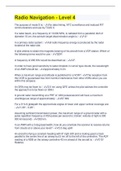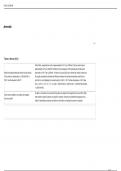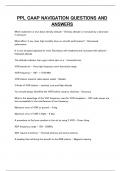Vor frequency mhz Study guides, Class notes & Summaries
Looking for the best study guides, study notes and summaries about Vor frequency mhz? On this page you'll find 33 study documents about Vor frequency mhz.
Page 4 out of 33 results
Sort by
PPL CAAP NAVIGATION QUESTIONS AND ANSWERS

-
Radio Navigation - Level 4 | 250 Questions with 100% Correct Answers
- Exam (elaborations) • 18 pages • 2022
-
- $10.49
- + learn more
The purpose of mode S is: - for data linking, ATC surveillance and reduced R/T communications and use by TCAS II. If a radar beam, at a frequency of 10.000 MHz, is radiated from a parabolic dish of diameter 15 cm, the azimuth target discrimination angle is: - 14° In a primary radar system: - all radio frequency energy is produced by the radar located at the radar site. A pilot wishes to obtain the magnetic bearing of his aircraft from a VDF station. Which of the following terms would he ...

-
Jeremiah Terms in this set (143) What is the approximate base of the cumulus clouds if the surface air temperature at 1,000 feet MSL is 70°F and the dewpoint is 48°F? When lifted, unsaturated air cools at approximately 5.4°F per 1,000 fee
- Exam (elaborations) • 11 pages • 2024
- Available in package deal
-
- $7.99
- + learn more
Jeremiah Terms in this set (143) What is the approximate base of the cumulus clouds if the surface air temperature at 1,000 feet MSL is 70°F and the dewpoint is 48°F? When lifted, unsaturated air cools at approximately 5.4°F per 1,000 feet. The dew point cools at approximately 1°F per 1,000 feet. Therefore, the convergence of the temperature and dew point lapse rates is 4.4°F per 1,000 feet. The base of a cloud (AGL) that is formed by vertical currents can be ...

Study stress? For sellers on Stuvia, these are actually golden times. KA-CHING! Earn from your study resources too and start uploading now. Discover all about earning on Stuvia



